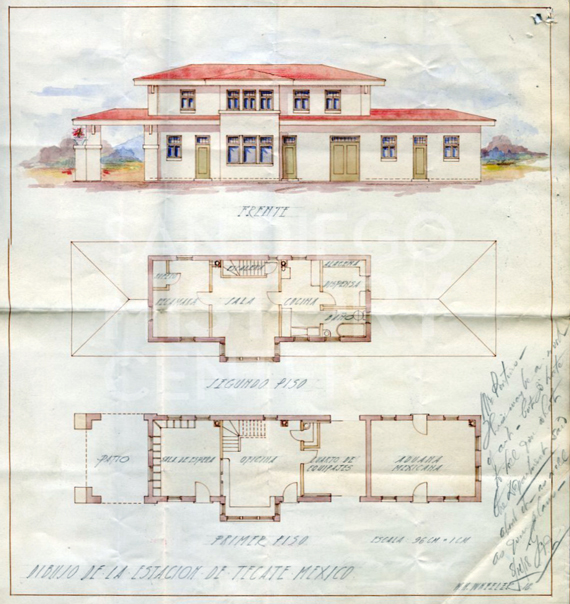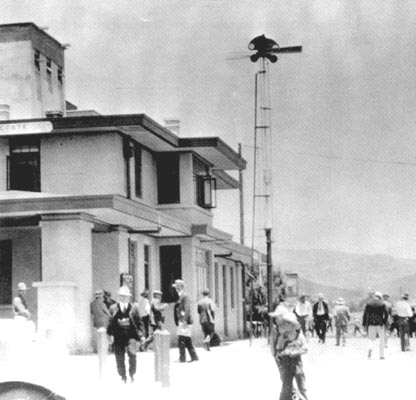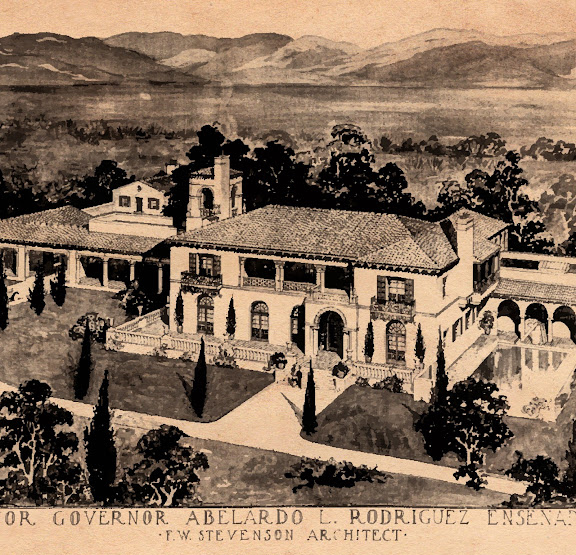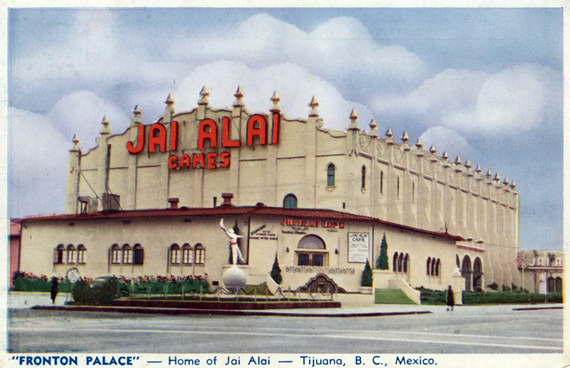|
William Wheeler & Other Master Architects of the Border Region
By Maria E Curry
November/December 2023
 Master architect William Wheeler made this watercolor drawing of the Tecate depot in August 1918. The two-story, Prairie style depot devoted the upper floor to living quarters. The handwritten note, signed by Wheeler, on the drawing’s right edge says: “Mr. Pontius - This may be a work of art but I hate to tell you what the Department said about it, as well as your plans.” We don’t know what “the Department” in Mexico objected to, but Wheeler evidently prevailed. The Department of Communication approved the design on August 5, 1918. Courtesy Pacific Southwest Railroad Museum |
 The Tecate depot was built in 1918-1919 as the western end of the Tijuana and Tecate railroad (1907-1919). The building served Tecate’s first industries, including a malt factory, a coffee milling plant, and the Tecate brewery. Courtesy Ticor Collection at the San Diego History Center |
 San Diego master architect Frank W. Stevenson designed the Abelardo L. Rodriguez residence for the former president of Mexico. The Spanish Revival style hacienda was built in 1930 and has been designated as part of Baja California’s cultural heritage. Courtesy Enrique Ibarra de Alba |
 This vintage postcard shows the Jai Alai building on Avenida Revolucion in Tijuana. Master architect Eugene Hoffman designed it in 1926, with Baroque Revival and Moorish elements, but World War II intervened and the building was not finished until 1947. Courtesy Tijuana Historic Archive |
San Diego and Tijuana have been selected jointly as the 2024 World Design Capital by UNESCO, becoming the first binational World Design Capital in history. As part of this celebration, both cities’ governments should be preserving their common heritage instead of destroying it.
The recent loss of the Red Bungalow, designed by master architect William Wheeler and beloved in Mission Hills and beyond, leaves an irreparable hole in San Diego and Tijuana’s shared design history. Both cities have architectural icons created by Wheeler and other San Diego master architects from the 1910s through the ‘40s, a period of historical significance for the border region.
The Mexican Revolution (1910-1920), World War I (1914-1918), the Great Depression (1929-39), and the Prohibition era (1920-1933) marked the emergence of Modernism in the binational region. Back then, Tijuana had no trained architects because it was disconnected from the major Mexican cities and universities.
As a result, San Diego architects had the opportunity to design and build myriad projects in Baja California: stations for the San Diego and Arizona and Tijuana-Tecate railroads, casinos, bars, hotels, businesses, and homes. They employed the same styles, construction techniques, and materials they were using in the United States. At the same time, buildings and houses were moved from San Diego to Baja California, forming a residential landscape that distinguishes northern border cities from the rest of Mexican cities.
Wheeler was the author of the two-story, Prairie style depot in Tecate (1918). Eugene Hoffman designed Tijuana’s Jai Alai building in 1926, while Wayne D. McAllister added the Agua Caliente casino and hotel to the city in 1927. In 1930, Frank W. Stevenson provided a grand house for the former Mexican president Abelardo L. Rodriguez in Ensenada.
All four men have been deemed master architects by the City of San Diego Historical Resources Board, and the buildings cited here are just a few examples of the cross-border design activity. The Americans’ works are legally eligible for designation as cultural heritage sites in Baja California, representing styles that were popular across the border, including Craftsman, Mission, Spanish Revival, and Prairie School.
Wheeler’s magnificent, two-story train depot in Tecate was saved from destruction in 2002, thanks to efforts of San Diegan and Mexican preservationists. Save Our Heritage Organisation placed the building on its Most Endangered List, as did the Great American Station Foundation. Pacific Southwest Railroad Museum members lobbied for its preservation and the Baja California community organized to save it. The Mexican government listened and restored the depot, thereby preserving one of Wheeler’s best works outside of the United States.
We urge San Diego and Tijuana mayors to join the 2024 World Design Capital celebration and actively demonstrate a true commitment to our shared heritage by preserving and landmarking valuable architectural resources, as well as old neighborhoods that reflect the region’s design history. And demolitions of master architects’ buildings on both sides of the border must stop immediately.
|
2025
2024
2023
2022
2021
2020
2019
2018
2017
2016
2015
|







